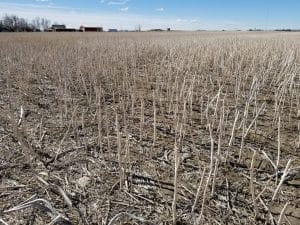1.Prep for good seed placement. This includes drill prep for even seed distribution and depth side to side and front to back. It may also require some residue management, but consider the risks. Residue management is best done with the combine. PAMI has results from a recent study on fan speed and its effect on seed placement.
2. Use the canola calculator to set seeding rates. An update to the seeding rate decision tool at canolacalculator.ca adds ‘seed cost’ to the equation. Try a few different scenarios to see the economic impact of factors such as seed size, percent emergence and target plant density.
3. Know the risks for seed-placed fertilizer. The safe recommendation for seed-placed fertilizer for canola is to apply no more than 20 lb./ac. of phosphate in the seed row. Place all other fertilizer, including extra required phosphate, in a side band or mid-row band where it will not harm germinating seeds. Read more. Note that many areas appear to be drier leading up to seeding, which will elevate the risk from seed-placed fertilizer. With that in mind, consider all options for using lower seed placed fertilizer rates. We had a question about safety difference between liquid and dry phosphate. Salt index of 10-34 is similar to 11-52, but seed-bed utilization might make a difference. Wide rows and narrow openers (like planter discs) will concentrate more fertilizer in the seed row. This could increase the risk somewhat. But with those rates of P, and everything else kept out of the seed row, we might be splitting hairs here.
4. Early seeding: How early is too early? That depends on the region. April is a pretty common seeding time in the Southwest Prairies, but it may be too early – based on frost risk and cold soils – in other parts of the Prairies. Yieldwise, long-term crop insurance data suggest that the first two weeks of May are a good target, in general. Read the Time of Seeding section in the Canola Encyclopedia.
5. Dry soils? Plan your seeding accordingly. This article helps answer the common questions: Should I seed early or wait for the moisture situation to improve? What seed-placed fertilizer rate is appropriate in dry conditions? Should I seed deep enough to reach moisture?
6. Plan your pre-seed weed control. The pre-seed window can be a good time to get winter annuals and perennials while they’re smaller. Options for use ahead of canola are glyphosate and glyphosate in a tank mix (recommended!) with quinclorac, bromoxynil, Aim/CleanStart (carfentrazone), clomazone and Conquer (bromoxynil and carfentrazone). Read more.
7. Assess the risk of herbicide carryover in fields planned for canola. Residual herbicides need moist soil and warm temperatures for breakdown to occur within the expected time frame. In dry conditions, the two major breakdown methods – hydrolysis and microbial degradation – will slow down, which elevates the risk that these herbicides will remain active in the soil for longer. Canola is sensitive to residual herbicide carryover. Read more for risk factors and 2019 risk maps.
8. Consider the valued surveyors. Surveys will start soon, which requires surveyors to be in the field. Among the benefits, these surveyors provide insect monitoring, including for bertha armyworm and diamondback moth, which are posted here. Surveyors follow strict biosecurity protocols.
9. Know the “Keep It Clean” priorities for 2019. They are summarized in this Canola Digest infographic. More details for canola, cereals and pulses are available at keepingitclean.ca.
10. Monitor bins. As weather turns from winter to spring to summer, keep checking canola bins. If you plan on carrying canola over into the summer, you may not need to turn the bins to warm them up, but you will want to make sure the canola is safe.

